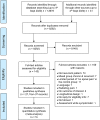Are neuromuscular adaptations present in people with recurrent spinal pain during a period of remission? a systematic review
- PMID: 33793608
- PMCID: PMC8016280
- DOI: 10.1371/journal.pone.0249220
Are neuromuscular adaptations present in people with recurrent spinal pain during a period of remission? a systematic review
Abstract
A plethora of evidence supports the existence of neuromuscular changes in people with chronic spinal pain (neck and low back pain), yet it is unclear whether neuromuscular adaptations persist for people with recurrent spinal pain when in a period of remission. This systematic review aimed to synthesise the evidence on neuromuscular adaptations in people with recurrent spinal pain during a period of remission. Electronic databases, grey literature, and key journals were searched from inception up to the 4th of September 2020. Eligibility criteria included observational studies investigating muscle activity, spine kinematics, muscle properties, sensorimotor control, and neuromuscular performance in adults (≥ 18 years) with recurrent spinal pain during a period of remission. Screening, data extraction, and quality assessment (Newcastle-Ottawa Scale) were conducted independently by two reviewers. Data synthesis was conducted per outcome domain. A meta-analysis with a random-effects model was performed where possible. The overall strength of evidence was rated using the Grading of Recommendations, Assessment, Development and Evaluation guidelines (GRADE). From 8292 records, 27 and five studies were included in a qualitative and quantitative synthesis, respectively. Very low level of evidence supports muscle activity changes in people with recurrent low back pain, especially greater co-contraction, redistribution of muscle activity, and delayed postural control of deeper trunk muscles. Reduced range of motion of the lumbar spine was also found. Meaningful conclusions regarding other outcome domains or people with recurrent neck pain could not be drawn. In conclusion, people with recurrent low back pain during a period of remission show muscle activity and spine kinematics adaptations. Future research should investigate the long-term impact of these changes, as well as adaptations in people with recurrent neck pain.
Conflict of interest statement
The authors have declared that no competing interests exist.
Figures



References
-
- Vos T, Allen C, Arora M, Barber RM, Brown A, Carter A, et al.. Global, regional, and national incidence, prevalence, and years lived with disability for 310 diseases and injuries, 1990–2015: a systematic analysis for the Global Burden of Disease Study 2015. Lancet. 2016;388(10053):1545–602. 10.1016/S0140-6736(16)31678-6 - DOI - PMC - PubMed
Publication types
MeSH terms
LinkOut - more resources
Full Text Sources
Other Literature Sources
Medical

